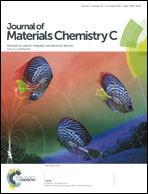Enhancement of photovoltaic performance by increasing conjugation of the acceptor unit in benzodithiophene and quinoxaline copolymers†
Abstract
Copolymers based on benzodithiophene and quinoxaline, represented by 4,8-bis(5-(3,4,5-tris(octyloxy)phenyl)thiophen-2-yl)benzo[1,2-b:4,5-b′]dithiophene (TOBDT) and 2,3-diphenyl-5,8-di(thiophen-2-yl)quinoxaline (TQ1) or 10,13-bis(4-(2-ethylhexyl)thiophen-2-yl)dibenzo[a,c]phenazine (TQ2), were synthesized via a Stille coupling reaction. By increasing the conjugation in the TQ2 unit, the polymer based on TQ2 showed a narrower band gap (Eg), a lower highest occupied molecular orbital energy level and enhanced interchain π–π interactions. Polymer solar cells based on TQ2 showed a simultaneous enhancement of the open-circuit voltage (Voc), short-circuit current density (Jsc) and fill factor (FF) compared with polymer solar cells based on the TQ1 polymer. A good power conversion efficiency of 4.24% was achieved by solar cells based on the TQ2 polymer and [6,6]-phenyl-C71-butyric acid methyl ester composite. These preliminary results indicate that increasing the acceptor unit (quinoxaline) conjugation is an effective way of improving the performance of polymer solar cells.


 Please wait while we load your content...
Please wait while we load your content...